Site menu:
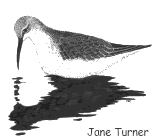
October 2016 Newsletter
Low Tide Wetland Bird Survey.
Wirral Wader Festival 2016.
Colour Ring Report.
September Bird News.
Forthcoming Events.
Latest Newsletter.
Low Tide Wetland Bird Survey
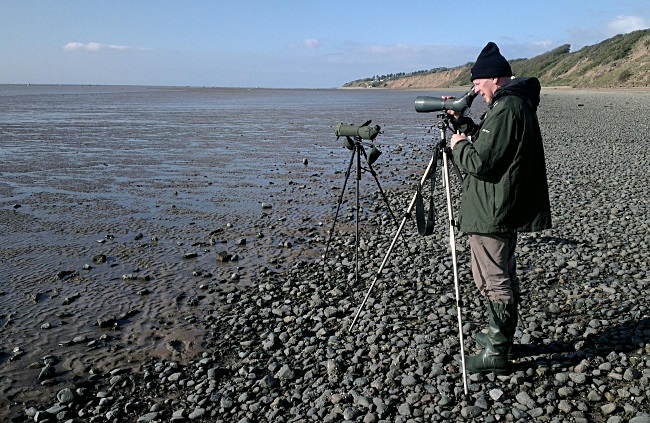
© Matt Thomas
It's November, cold but with no wind,
and it is low tide. Ideal
for a trip to Thurstaston Shore. When I get to the beach I set up my
telescope and do a quick scan - it never ceases to amaze me just how
many birds are out there. Knot and Oystercatchers are vying
for
the most numerous species, at least 20,000 of each, then many
hundreds, thousands, of Dunlin, Pintail, Redshank,
Black-tailed
Godwit,
Shelduck, Bar-tailed Godwit, Lapwing, Golden Plover, Grey
Plover............. Many birds are feeding
on the mud close to the beach or roosting in the channel, an awful lot
more are out on Dawpool Bank in the middle of the estuary and even with
a
powerful telescope they are little more than grey dots.
Much
as I would like to just stand and stare at the birds I have a job to
do; it's my day to do a Low Tide Wetland Bird Survey. This means I have
to split those grey dots into species and count them. Not only that; in
the section of the Dee estuary which is my area to count there are ten
sectors and, somehow, I have to work out where these sectors are on the
vast mud flats and count the birds in each one. But I enjoy the
challenge.
Some of the counts are done from the cliff top at various points
between Heswall and West Kirby, some from the beach, some from the end
of the causeway at Dee Sailing club. In some areas, such as Parkgate,
there is no alternative but to walk out on to the estuary and here
local knowledge is vital as the unwary can get caught in deep mud, fall
into deep gutters or get trapped by the returning tide. You have to
know what you are doing! In my area the only place I need to walk out
to is Tanskey Rocks and I know a route which is mainly sand rather than
mud, there I can get decent views of the birds feeding on the mussel
beds and in the channels. I do the counts over a period of two
days, it takes about three hours each day, I return home tired
but happy!

© Richard Smith
These low tide WeBS counts only take place once
every seven years due to to the large amount of organisation and work
required (the High Tide WeBS are monthly). They are important as the
limiting factor for the number of birds using the estuary is the amount
of food available, more so than the number of roost sites, and it is
feeding birds we are counting. They add a further dimension to our
understanding of estuaries and the birds which use them, and they are
useful for combating developers as we can say exactly how many birds
will be affected by any proposed loss of mud flats. For example, low
tide WeBS data
was used when successfully stopping development at both Rock Ferry on
the Mersey estuary, and the proposed extension of Southampton Docks at
Dibden Bay.
Low Tide WeBS counts have taken place on the Dee estuary in the winters of 1996/97, 2001/02, 2008/09 and 2014/15. The data is on-line at http://app.bto.org/webs-reporting/. It's fascinating looking at the distribution maps for the different species and seeing how their requirements differ, for example Bar-tailed Godwits are almost exclusively seen along north Wirral, where it's mainly sand, whereas Black-tailed Godwits are only seen in the estuary itself where there is thick mud. One thing that is noticeable is that in one of my favourite birding haunts, the shore off Thurstaston and Caldy, now attracts both Pintail and Bar-tailed Godwits in good numbers (as shown in the maps for 2014/15), whereas in 2001/02 not a single Pintail was counted in that area and Bar-tailed Godwits were rare there.
Richard Smith
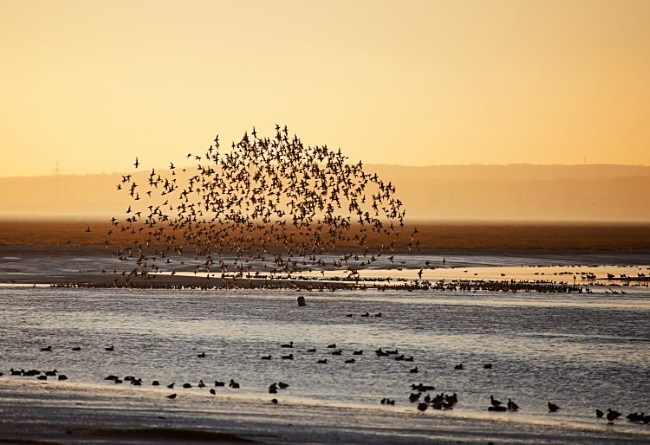
http://www.fromthemuddybanksofthedee.com/

WIRRAL WADER FESTIVAL Sat 1st and Sun 2nd October.
Click here to download a complete list of events which includes Hoylake High Tide Birdwatches on both days, Sunset walk to Hilbre, High Tide Birdwatches at West Kirby, Low Tide Birdwatches at Thurstaston plus various Stalls, Talks, Stands etc. at Thurstaston Visitor Centre.
Colour Ring Report
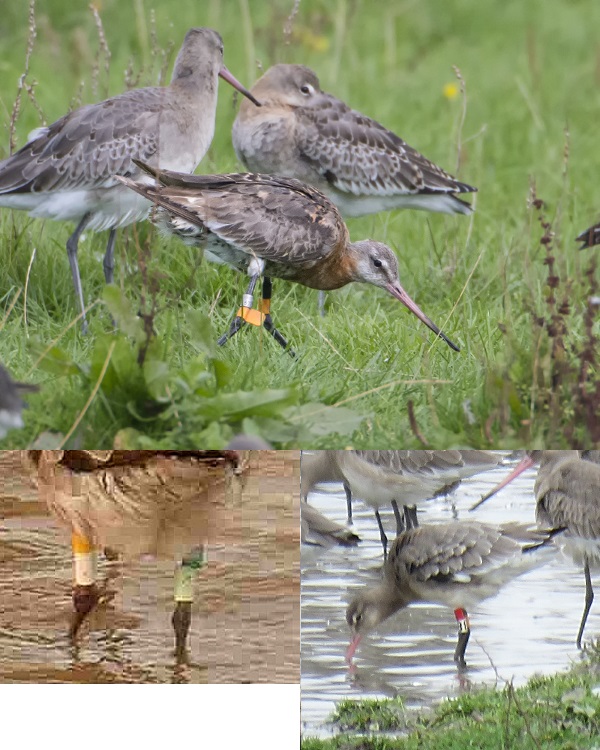
We continue to have no luck trying to spot
colour-rings on small waders and, although there are plenty around, we
saw no colour-rings on any gull in September. So it's mainly
Black-tailed Godwits, we have had at least 26 different colour-ringed
ones since they returned from breeding in mid-July, being seen at
Burton Mere Wetlands, Connah's Quay, Gilroy and Thurstaston.
We
describe the life history of four of them. The only other
bird
was a ringed Canada Goose and this is the third year in a row that
we've had a Canada Goose which was ringed at Bowness, on Lake
Windermere.
Black-tailed Godwits
NO-mOflag, ringed on the Atlantic coast of France on November 8th, 2007.Recorded at Connah's Quay on August 4th 2016 where it stayed until September 2nd. It then moved to Gilroy, West Kirby, first seen there on September 8th and still present at month-end.
After it was ringed it was seen in the same area of France the following three winters, up to 2011/12. It was then recorded on the Tagus estuary, Portugal, on February 2nd 2012. Before turning up at Connah's Quay this year the only record outside France and Portugal was at Inner Marsh Farm on July 9th 2010.
As you may be able to tell from the photo this bird has a damaged leg, we think an old break or perhaps it is dislocated. Some birds do damage themselves by flying into fences in Iceland so it's possible that is what has happened. The leg is obviously very uncomfortable for the bird but it appears to be surviving OK.
OW-GL, ringed in Iceland on June 14th 2010 as an adult female.
Recorded at Connah's Quay on September 4th 2016.
This birds spends every spring and return migration in Kent, mainly on the Oare Marshes. It was recorded back in Iceland in April 2011. Mid-winter records are almost non-existent but it has been seen twice in Portugal so it is likely that is where it over-winters.
R8-GO, ringed in Iceland on July 14th 2010 as an adult male.
Recorded at Gilroy, West Kirby, from August 22nd to September 24th 2016.
First record after ringing, in August 2011, was also at Gilroy and it spent the following three winters on the Dee Estuary. September 2012 saw it on the Humber estuary and September 2015 at Gibraltar Point, Lincs. The only record outside the UK was back in Iceland in May 2014.
LW-WN, ringed in southern Iceland on June 19th 2015, as a chick.
Recorded at Connah's Quay on September 9th and 20th 2016.
First record after ringing was in Morar, Invernesshire, in August 2015, from there it moved to Conwy RSPB reserve where it was in late September and early October 2015. It was at Gilroy on October 2015. April and early May 2016 saw it at Leighton Moss.
Canada Goose
FAHH, white letters on red ring.Ringed at Bowness-on- Windermere on June 26th 2016.
Recorded at West Kirby (in the Caldy Wildfowl collection) on September 15th 2016.
This bird was ringed by the RSPCA Ringing Group as part of a project looking at movements to and from Lake Windermere, Cumbria, where the majority are ringed during the annual moult period.
Richard
Smith and Matt Thomas.
Colour-rings were also reported by Steve Hinde, Richard Beckett, Peter
Haslem and Charles Farnell.
September Bird News
The passage of Curlew Sandpipers which
started in
August continued all month, max counts were 13 at Burton Mere Wetlands
on the 8th and 12 at Hilbre on the 27th. Other passage waders were
recorded with max counts of: four Little Stints at Burton Mere
Wetlands; 20 Spotted Redshanks at Connah's Quay; 18 Greenshanks at
Connah's Quay with 12 at Burton Mere Wetlands; nine Ruff at Burton Mere
Wetlands. Black-tailed Godits continued to use the Gilroy field to
roost and this flock could be seen feeding off Caldy and Thurstaston at
low tide, several hundred also roosted in the Caldy Wildfowl collection
making a total flock size of well over 3,000.

12 Spoonbills were at Burton Mere Wetlands early in the month, but then dispersed. At least 10,000 Common Scoters off Meols and Hoylake were an amazing sight, easily a record high for September but such huge numbers are now almost regular off north Wirral and it's interesting that they nearly always appear during the return and spring migration which would suggest these birds spend the winter further south.
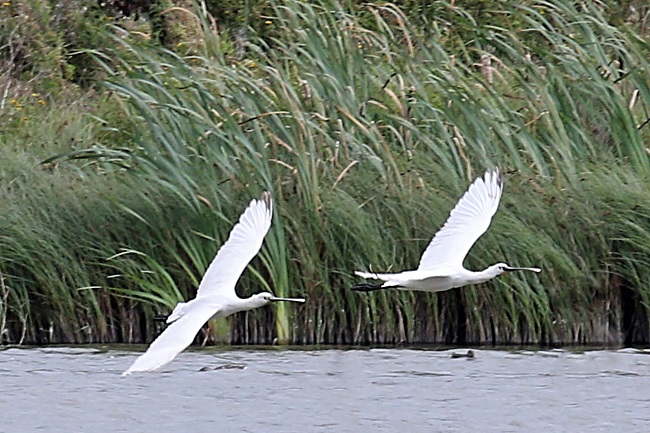
Marsh Harriers were present all month, with max four on the 24th, and at least one ringtail Hen Harrier. An Osprey flew over West Kirby on the 12th and a Red Kite over Neston on the 23rd. No Short-eared Owls appeared in contrast to the exceptional numbers last year when there were a total of 34 records.
There were no prolonged north-westerly gales as hoped for, but we did get a strong westerly right at the end of the month which brought in loads of good birds, highlights which were two Leach's Petrels and two Pomarine Skuas, and hundreds of Gannets!

Richard Smith.
What to expect in October
October is also a month when we can expect gales, and a prolonged north-westerly will blow in Leach's Petrels, Sabine's Gulls and a selection of skuas among the more regular sea birds. Calmer weather should reveal thousands of Common Scoters and hundreds of Great Crested Grebes on the sea off north Wirral, this area of Liverpool Bay is one of the most important in the country for these species.
Mid-month sees a couple of very high tides (10 metre, Liverpool) and that should cover the marsh at Parkgate flushing the returning Short-eared Owls and thousands of wildfowl. Waders will be returning in good numbers and less common ones migrating through should include Curlew Sandpipers, Little Stints and Spotted Redshanks.
October is a particularly good month for rarities, this was my summary for October 2015 "a Slavonian Grebe at Hilbre; a fly over probable Olive-backed Pipit at West Kirby; two records of Richard's Pipit; a Spotted Crake, a Pectoral Sandpiper, several records of Cetti's Warbler and Yellow-browed Warbler at BMW (Burton Mere Wetlands); four further sightings of Yellow-browed Warbler; a Pallid Harrier over Hoylake".
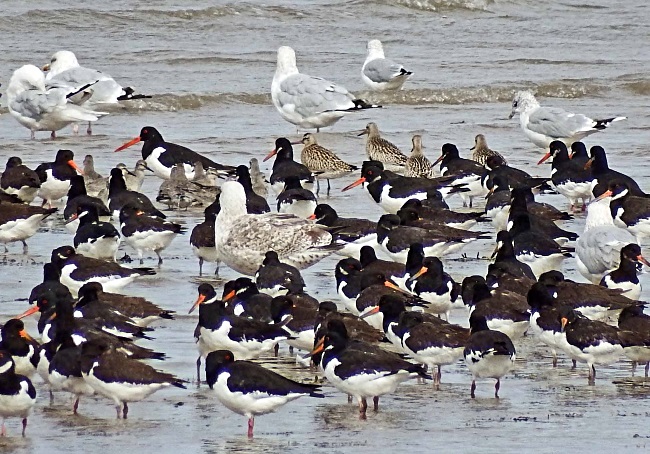
Top of Page
Forthcoming Events
October Highest Spring Tides (Liverpool)
Also
see Tides
page.
16th October, 11.48hrs (BST), 9.9m.
17th October, 12.30hrs (BST), 10.0m.
18th October, 13.14hrs (BST), 10.0m.
19th October, 13.58hrs (BST), 9.8m.
Forthcoming Events
Organised by the Wirral
Ranger Service , Flintshire
Countryside Service and the
RSPB (Dee Estuary):
All these events and walks have bird interest, even those not
advertised specifically for birdwatching. No need to book for these
events unless specified - please check below.

WIRRAL WADER FESTIVAL Sat 1st and Sun 2nd October.
Click here to download a complete list of events which includes Hoylake High Tide Birdwatches on both days, Sunset walk to Hilbre, High Tide Birdwatches at West Kirby, Low Tide Birdwatches at Thurstaston plus various Stalls, Talks, Stands etc. at Thurstaston Visitor Centre.
Saturday 8th October, An Evening with Egrets at Burton Mere Wetlands.
4:45-7 pm
Price: Adult £6.50 (RSPB members £5), children half adult prices
Booking essential: ring 0151 353 8478.
The Dee Estuary is home to the largest colony of little egrets in the North of England and they all roost together overnight in the treetops of Marsh Covert, a small woodland beside Burton Mere Wetlands; currently over 300 are making their home here, plus two great white egrets!
Come along for this exciting evening walk to learn about the troubled past and current success of little egrets in the UK, with a walk up to Burton Point to watch as hundreds of egrets pour in towards the roost from around the estuary. This truly is one of the best wildlife spectacles at this time of year, but places are limited so book early to avoid disappointment.
The walk is around 2 miles in total and includes the Hillfort Trail which crosses grassed farmland. Price includes a hot drink in the Reception Hide after the walk.
Directions:
RSPB Burton Mere Wetlands, Puddington Lane, Burton, Cheshire, CH64 5SF
Saturday 15th October, Autumn Arrivals at Point of Ayr.
9 am-12 pm
Price: Free, but donations gratefully received on the day.
Booking essential - ring 0151 353 8478.
By mid-Autumn we'll have welcomed many of our Winter visitors back to the mudflats and saltmarsh that make the Dee Estuary such an important home for wetlands birds, and witnessing a high tide at the Point of Ayr is a spectacle not to be missed.
Thousands of godwits, redshanks, oystercatchers and curlews gather in spectacular fashion on the saltmarsh and shingle here at high tide, which is what we hope to show you if you join us on this gentle walk from Talacre to our hide. There'll also be a variety of ducks - pintail, shelduck, teal and mallard - pushed close on the incoming tide, and there's always the chance that something unexpected will show its face! Peregrine and merlin are the two raptors most likely to take advantage of this high tide buffet, so there's a chance of seeing these hunting at close range.
Park in one of the public car parks signposted from Station Road and meet outside the Smuggler's Inn at the end of Station Road. Appropriate clothing and footwear are essential. The path is fully accessible, but a motorcycle gate at the beginning of the walk may make it difficult for larger wheelchairs. High tide is at 11:06 am so feel free to pack some snacks for in the hide, and a hot flask is recommended at this time of year!
Directions:
Point of Ayr, Flintshire. Meet outside the Smuggler's Inn at the end of Station Road.
Monday 17th October and Tuesday 18th October, Parkgate High Tide Birdwatch.
Start times vary, best to arrive a minimum of one hour before high tide (see below).
Price: Free
Parkgate Marsh is one of the best wetland habitats in North West England, but until you've witnessed the spectacle of a rising Spring tide, it's impossible to appreciate just how much wildlife makes its home here.
Thousands of wildfowl and wading birds that are here for the winter are pushed closer by the rising water and there's a chance of a hunting peregrine trying it's luck. Small mammals usually hidden in the grasses are flushed from cover, offering a feeding frenzy for the kestrels, harriers and short-eared owls.
Join us at Parkgate's Old Baths car park and the Donkey Stand near Nicholl's ice cream shop, where we'll be set up with marquees and telescopes hoping for the right weather conditions to really push the tide in.
Car parking is limited on Parkgate promenade, but there is free public parking at the Old Baths car park (CH64 6RN) at the north end of The Parade, and the Wirral Country Park car park on Station Road (CH64 6QJ). There are public toilets at Mostyn Square in the middle of The Parade, and a number of pubs and cafes for refreshments.
Ring 0151 353 8478 for further details.
High tide times:
Monday 17th October: 12.30 pm (10.0m)
Tuesday 18th October: 1.14 pm (10.0m)
Sunday 30th October, Raptor Watch at Parkgate.
1pm to dusk.
Join us for a chance to see up to seven different birds of prey including peregrine and merlin, plus two types of owl that all make their home on the RSPB Dee Estuary nature reserve. With its panoramic views of the saltmarsh, Parkgate is one of the best places to watch for the birds hunting.
Stick around until dusk for a chance to see the graceful and endangered hen harriers flying into roost for the night on the marsh close to the Old Baths car park, plus a ghostly barn owl emerging to hunt.
No booking required, come along any time between 1 pm and sunset. Dress appropriately for the weather and don't forget your binoculars! Public toilets and various pubs and cafes are situated close by along Parkgate promenade.
Ring 0151 353 8478 for further details.
Directions
The Old Baths car park, Parkgate (just north of The Boathouse pub)
Tuesday 15th November and Wednesday 16th November, Parkgate High Tide Birdwatch.
Start times vary, best to arrive a minimum of one hour before high tide (see below).
Price: Free
Parkgate Marsh is one of the best wetland habitats in North West England, but until you've witnessed the spectacle of a rising Spring tide, it's impossible to appreciate just how much wildlife makes its home here.
Thousands of wildfowl and wading birds that are here for the winter are pushed closer by the rising water and there's a chance of a hunting peregrine trying it's luck. Small mammals usually hidden in the grasses are flushed from cover, offering a feeding frenzy for the kestrels, harriers and short-eared owls.
Join us at Parkgate's Old Baths car park and the Donkey Stand near Nicholl's ice cream shop, where we'll be set up with marquees and telescopes hoping for the right weather conditions to really push the tide in.
Car parking is limited on Parkgate promenade, but there is free public parking at the Old Baths car park (CH64 6RN) at the north end of The Parade, and the Wirral Country Park car park on Station Road (CH64 6QJ). There are public toilets at Mostyn Square in the middle of The Parade, and a number of pubs and cafes for refreshments.
Ring 0151 353 8478 for further details.
High tide times:
Tuesday 15th November: 11.10 am (10.0m)
Wednesday 16th November: 11.56 am (10.0m)